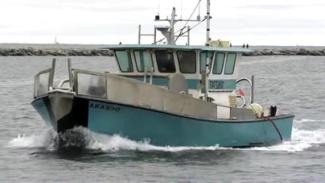Gillnet Observer Survey
Background
The RI Gillnet Observer Survey is one of the newest at-sea sampling programs beginning in June of 2023. This sampling takes place aboard commercial fishing vessels gillnetting in Rhode Island State waters. The main focus of this project is to collect bycatch and discard data on target species in the gillnet fishery to better characterize fishing behavior and understand the potential impacts of alternative regulations requested by industry.
Survey Design
This survey aims for a target of 5% sampling coverage per week of gillnet trips in RI State Waters. At this coverage rate, 1-2 trips per week are taken from various commercial fishing ports such as Galilee, Sakonnet, and Newport. Target species include striped bass, bluefish, Atlantic menhaden, black sea bass, summer flounder, winter skate, little skate, and spiny dogfish.
Survey Gear
The target species are collected with commercial gillnet gear that varies by fishing operation. Gillnets are a type of fixed gear typically set out in the water for ~24 hours. A typical gillnet panel is about 10-12 feet high, 300 feet long, is anchored at the bottom of the ocean, and connected and retrieved using highflyer buoys. Each commercial fisherman sets various amounts of nets out in different locations based on their fishing history in their given area. Gear can vary regarding mesh size, net height, and number of panels.
Sampling Methods
On each trip an initial safety check is performed to make sure required safety equipment is present in case of an emergency. On the steam out, gear data is collected from the captain about their nets; this includes net height, mesh size, number of net panels they plan to haul, and the soak time. When the boat arrives at the first string of nets, the haul coordinates, depth, time, and wave height are recorded. At each haul, the captain and crew bring up the nets and sort out the catch.
For any target species encountered, the observer retrieves it from the captain and records the weight, length, disposition (kept or discarded), and status of the fish (dead, alive, damaged). Shark interactions are fairly common in this gear type and for each shark caught in the nets the observer or captain will identify the species and note the coordinates it was caught at. The same protocol will be followed in the event of any marine mammal, endangered, or threatened species encountered.
Sampling Frequency
This survey takes place during the months of April-November. Sampling is based on the fishermen’s schedule and weather which varies week to week, but the target is for 1-2 trips per week during these months.
For more information about the survey please contact Nicole Lengyel Costa



